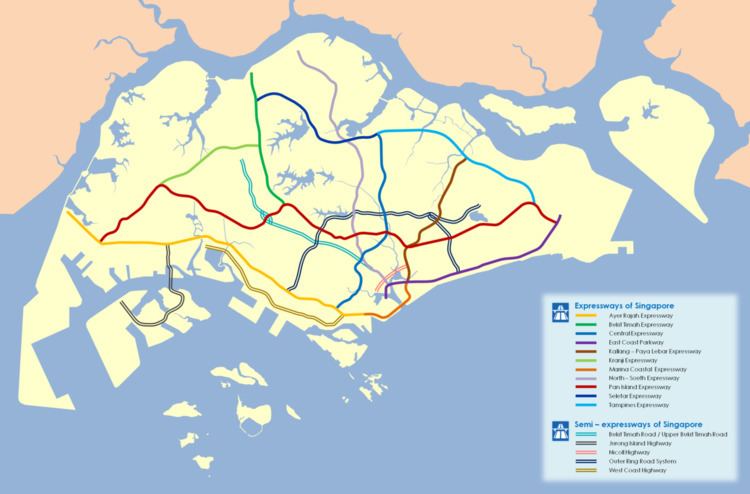Length: 163 km (101 mi) Expressways Expressway AAA (AAA) | Formed: 1966 | |
 | ||
The Expressways of Singapore are special roads that allow motorists to travel quickly from one urban area to another. All of them are dual carriageways with grade-separated access. They usually have three to four lanes in each direction, although there are two-lane carriageways at many expressway - expressway intersections and five-lane carriageways in some places. There are ten expressways, including the new Marina Coastal Expressway. Studies about the feasibility of additional expressways are ongoing.
Contents
Map of CTE, Singapore
Construction on the first expressway, the Pan Island Expressway, started in 1966. As of 2014, there are 163 kilometres (101 mi) of expressways in Singapore.
The Singaporean expressway networks are connected with Malaysian expressway networks via Ayer Rajah Expressway (connects with the Second Link Expressway in Malaysia) and Bukit Timah Expressway (connects with the Skudai Highway via Johor–Singapore Causeway).
Expansion
The latest expressway completed is the Marina Coastal Expressway which runs for 5 km, 3.5 km of which are underground. Construction started in 2008 and ended in late 2013. It was opened to the public on 29 December 2013. Prior to construction of the Marina Coastal Expressway, the Kallang–Paya Lebar Expressway which runs for 12 km, 9 km of which are 10 m underground, was started in 2001 and a 3 km section linking the Pan Island Expressway and East Coast Parkway was opened in late 2007. The Kallang–Paya Lebar Expressway was completed on 20 September 2008.
On 27 July 2007, the Land Transport Authority announced that approval had been given for the construction of a new 5 km long Marina Coastal Expressway (MCE) at a cost of $2.5 billion. The expressway, which includes Singapore's first undersea tunnel, links the East Coast Parkway and Kallang-Paya Lebar Expressway to Marina South and Ayer Rajah Expressway and opened to traffic 29 December 2013.
Construction of the 11th expressway, the North–South Expressway, was announced on 30 January 2008. The new 21-kilometre expressway will cost about $7 to $8 billion when fully completed by 2020 and will connect the East Coast Parkway with the northern parts of Singapore.
Features
There are no traffic lights on the expressways. At an interchange with another road, an expressway is connected to it via slip roads. This allows traffic to change routes without having to stop or slow down. Due to the need to conserve space in land-scarce Singapore, there are no cloverleaf interchanges on the entire island. Instead, traffic efficiency and land space are maximized by having traffic lights on terrestrial roads, as well as the usage of interchanges such as stack interchanges. The most common forms of highway-road or highway-highway intersections are single-point urban, diamond, and trumpet interchanges.
The road surface is asphalt, unlike normal roads which may have concrete surfaces. The lanes are separated with white dashed lines, while unbroken white lines are used to mark the edges of the median and shoulder. The shoulder is reserved for stops due to breakdowns and emergencies, and motorists are prohibited by law from travelling on it. Lanes are numbered from right to left, with lane 1 being the closest to the median. Crash barriers, cat's eyes and rumble strips are also used to ensure road safety.
There are signs marking the start and end of an expressway at its entry and exit points respectively. The expressways are also assigned route codes consisting three letters that form their respective initials, making the Singaporean expressway network as the only highway system with route coding system in Singapore. The Expressway Monitoring and Advisory System is used on all the expressways—cameras are used for live monitoring of expressway conditions, and LED signboards display information messages, such as warnings of any disruptions to the normal flow of traffic, as well as estimated travel times. The longest expressway, the Pan Island Expressway, is only 41 km (25 mi) long and therefore has no rest areas.
Safety
The default speed limit and National Speed Limits on Singapore expressways is 90 km/h (56 mph), but in certain areas a lower speed limit such as 80 km/h (50 mph) or 70 km/h (43 mph) is applied, especially in large urban areas, tunnels, heavy traffic and crosswinds. Speed traps are also deployed by the Singapore police at many places along the expressways and are deployed from 7am to 12am.
Certain types of transport, such as pedestrians, bicycles, and learner drivers, are not allowed.
Semi-expressways
In Singapore, there are five semi-expressways: Bukit Timah Road, Jurong Island Highway, Nicoll Highway, the Outer Ring Road System (ORRS) and West Coast Highway. These semi-expressways are scaled down versions of expressways. Semi-expressways do not have a uniform speed limit through its entire length, and some sections still feature traffic light controlled junctions, such as the eastern section of the ORRS and the controlled roundabout along the West Coast Highway. Still, just like expressways, semi-expressways allow motorists to travel quickly from one urban area to another with the use of viaducts, flyovers and underpasses.
